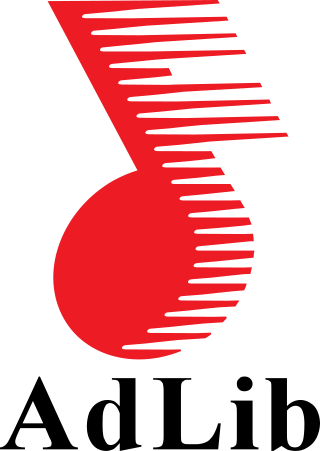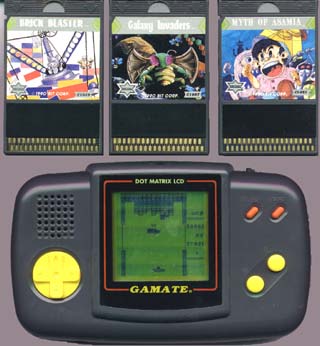
The Apple II series is a family of home computers, one of the first highly successful mass-produced microcomputer products, designed primarily by Steve Wozniak, manufactured by Apple Computer, and launched in 1977 with the original Apple II.

A sound card is an internal expansion card that provides input and output of audio signals to and from a computer under the control of computer programs. The term sound card is also applied to external audio interfaces used for professional audio applications.

The Tandy 1000 is the first in a line of IBM PC compatible home computer systems produced by the Tandy Corporation for sale in its Radio Shack and Radio Shack Computer Center chains of stores. Introduced in 1984, the product line was aimed at providing affordable but capable systems for home computing or education, with some of its Tandy specific features like graphics, sound and joystick port making it more appealing for home use.

Ad Lib, Inc. was a Canadian manufacturer of sound cards and other computer equipment founded by Martin Prevel, a former professor of music and vice-dean of the music department at the Université Laval. The company's best known product, the AdLib Music Synthesizer Card (ALMSC), or simply the AdLib as it was called, was the first add-on sound card for IBM compatibles to achieve widespread acceptance, becoming the first de facto standard for audio reproduction.

Sound Blaster is a family of sound cards and audio peripherals designed by Singaporean technology company Creative Technology. The first Sound Blaster card was introduced in 1989.

The Apple IIGS is a 16-bit personal computer produced by Apple Computer. It is the fifth and most powerful of the Apple II family. It is compatible with earlier Apple II models but has a Macintosh look and feel, and resolution and color similar to the Amiga and Atari ST. The "GS" in the name stands for "Graphics and Sound", referring to its enhanced multimedia hardware, especially its state-of-the-art audio.

The Apple IIc is a personal computer that was introduced by Apple Inc. shortly after the launch of the original Macintosh. It was a compact and portable version of the Apple II series of computers. The IIc featured a built-in floppy disk drive and a keyboard, and was often sold with its matching monitor. The c in the name stood for compact, referring to the fact it was a complete Apple II computer setup with a floppy drive that was squeezed into a smaller notebook-sized housing. It was compatible with a wide range of software and peripherals.

The Covox Speech Thing is an external digital-to-analog converter (DAC) that plugs into the parallel printer port of a PC. It converts 8-bit digital sound using a simple R-2R resistor ladder into an analog signal output.

There have been various families of Yamaha audio controllers labelled as YMF7xx.

Applied Engineering, headquartered in Carrollton, Texas, was a leading third-party hardware vendor for the Apple II series of computers from the early 1980s until the mid-1990s.

The AY-3-8910 is a 3-voice programmable sound generator (PSG) designed by General Instrument in 1978, initially for use with their 16-bit CP1610 or one of the PIC1650 series of 8-bit microcomputers. The AY-3-8910 and its variants were used in many arcade games—Konami's Gyruss contains five—and Bally pinball machines as well as being the sound chip in the Intellivision and Vectrex video game consoles, and the Amstrad CPC, Oric-1, Colour Genie, Elektor TV Games Computer, MSX, and later ZX Spectrum home computers. It was also used in the Mockingboard and Cricket sound cards for the Apple II and the Speech/Sound Cartridge for the TRS-80 Color Computer.
The Apple II line of computers supported a number of Apple II peripheral cards. In an era before plug and play USB or Bluetooth connections, these were expansion cards that plugged into slots on the motherboard. They added to and extended the functionality of the base motherboard when paired with specialized software that enabled the computer to read the input/output of the devices on the other side of the cable or to take advantage of chips on the board - as was the case with memory expansion cards.
Apple II system clocks, also known as real-time clocks, were devices in the early years of microcomputing. A clock/calendar did not become standard in the Apple II line of computers until 1986 with the introduction of the Apple IIGS. Although many productivity programs as well as the ProDOS operating system implemented time and date functions, users would have to manually enter this information every time they turned the computer on. Power users often had their Apple II's peripheral slots completely filled with expansion cards, so third party vendors came up with alternative approaches with products like the Serial Pro and No-Slot Clock.
Apple II accelerators are computer hardware devices which enable an Apple II computer to operate faster than their intended clock rate.
Orange Micro Inc. was an American computer hardware company that made products for use with Apple computers. The company made a variety of products for many machines, ranging from the Apple II series to the Macintosh line. The company went out of business in 2004.

Votrax International, Inc., or just Votrax, was a speech synthesis company located in the Detroit, Michigan area from 1971 to 1996. It began as a division of Federal Screw Works from 1971 to 1973. In 1974, it was given the Votrax name and moved to Troy, Michigan and, in 1980, split off of its parent company entirely and became Votrax International, Inc., which produced speech products up until 1984.

Media Vision Technology, Inc., was an American electronics manufacturer of primarily computer sound cards and CD-ROM kits, operating from 1990 to approximately 1995 in Fremont, California. Media Vision was widely known for its Pro AudioSpectrum PC sound cards—which it often bundled with CD-ROM drives—it is also known for its spectacular growth and demise.

The Gamate, known as 超級小子 in Taiwan and 超级神童 in China, is a handheld game console manufactured by Bit Corporation in the early 1990s, and released in Australia, some parts of Europe, Asia, Argentina, and the United States.
Throughout its lengthy, multi-model lifespan, the Apple II series computers lacked any serious built-in sound capabilities. At the time of its release in 1977, this did not distinguish it from its contemporaries, but by 1982, it shared the market with several sound-equipped competitors such as the Commodore 64, whose SID chip could produce sophisticated multi-timbral music and sound effects.
The OPL series are a family of sound chips developed by Yamaha. The OPL series are low-cost sound chips providing FM synthesis for use in computing, music and video game applications.















